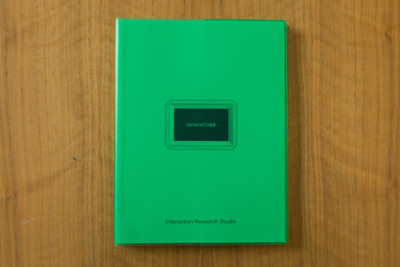Datacatcher
Boucher, Andy; Cameron, David; Gaver, William and Pennington, Sarah, eds. 2015. Datacatcher. Goldsmiths, University of London. ISBN 978-1-906897-35-2 [Book]
![[img]](https://research.gold.ac.uk/18597/1.hassmallThumbnailVersion/Datacatcher_cover.jpg)
|
Text
Datacatcher_cover.jpg Download (3MB) | Preview |
|
|
Text (Datacatcher Book)
DATACATCHER Book.pdf Permissions: GRO Registered Users Only Download (15MB) |
Abstract or Description
The Datacatcher is a mobile device with a screen on one end and a large control dial set in a recess underneath. Short sentences appear on the screen every few seconds, providing facts about the surrounding area. Topics include average house prices, typical income, the number of pubs or of GP surgeries. Turning the dial one way scrolls through all the messages that have appeared on the device; turning it the other way accesses a set of poll questions that can be answered using the dial to select among alternatives.
The Datacatcher was designed to support multiple orientations. Its primary use is to give a sense of the sociopolitical texture of the neighbourhoods where it is used. The messages are derived from public and private datasets, such as the census and credit agency data. As we will explain, our initial motivation was to support an expanded view of environmental issues by linking them to related concerns. The Datacatchers are also relevant to current activities aimed at making data more transparent and empowering — indeed, during a test of an early version of the Datacatcher, one participant said that it presented ‘Big Data for little people’.
To understand the multiple engagements the Datacatcher would afford, we manufactured 130 prototypes and distributed them to people in the Greater London area, who used them for up to two months. Before this project, our usual studio practice was to build one-off prototypes to be loaned to one or a few participants at a time. Integral to our funding bid — accepted for 5-year-funding by the European Research Council — was the goal of batch producing prototypes to lend to many participants simultaneously. This project is the last phase of that programme and represents a massive expansion in our capability, as we moved from building tens to hundreds of research prototypes. It was also the riskiest tranche of the research as we invested in developing a device more technically advanced than anything we had built before.
Designing, developing, and managing the deployment of so many research devices meant that, at various times, the studio had to expand significantly. This publication reflects that growth by incorporating viewpoints and descriptions of practices from the many people involved with the project, even if their involvement was brief, or tangential. Their diverse voices tell the story of how the Datacatcher developed from early conceptual ideas, though development dramas and hurdles to its deployment to people in and around London.
The sections of this book — Politikos, Something about, Develop, Manufacture, Participants, And then, Voices — show the trajectory of the project with dozens of images and short texts, but this is still only a small selection of the vast number of ideas and proposals generated by the project. Though the contents are an edited selection, we have tried to include a fair number of red herrings — design paths not taken because of technical challenges or time restrictions — because these may be of interest in their own right.
Although this publication predominantly focuses on the processes around the design of the Datacatcher as a device, perhaps the true outcome of this project — of any of our projects — are the participants’ experiences during its deployment. We hired two documentary filmmaking teams to capture these experiences, and a selection from the transcripts of their videos can be found in the final section of this book. It is the participants’ voices that tell us what it is we have made. This is not a simple and unitary narrative, however; each one has their own version to tell, and the experiences they describe vary so widely they might be describing different devices. Rather than producing a clear account then, the voices mingle and weave to create a kind of polyphonic, fragmentary story of the Datacatcher — one that will resonate through our future research and practice.
|
Item Type: |
Book |
| Departments, Centres and Research Units: |
|
| Date: |
2015 |
| Item ID: |
18597 |
| Date Deposited: |
21 Jun 2016 12:19 |
| Last Modified: |
10 Dec 2020 17:31 |
|
URI: |
View statistics for this item...
 |
Edit Record (login required) |

 Tools
Tools Tools
Tools
